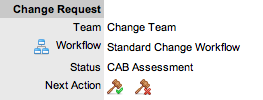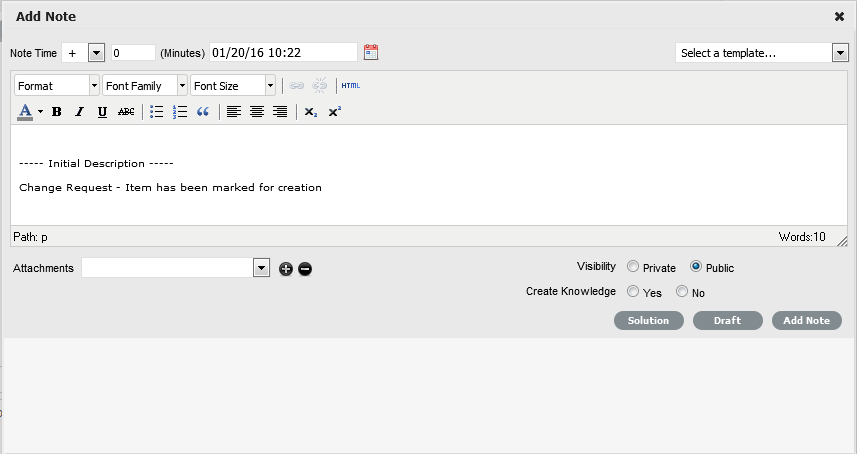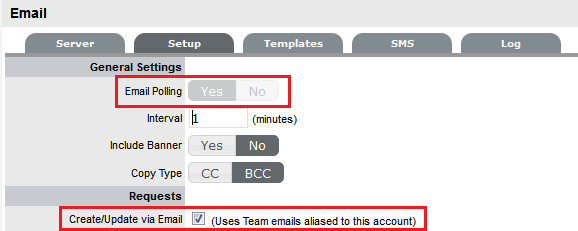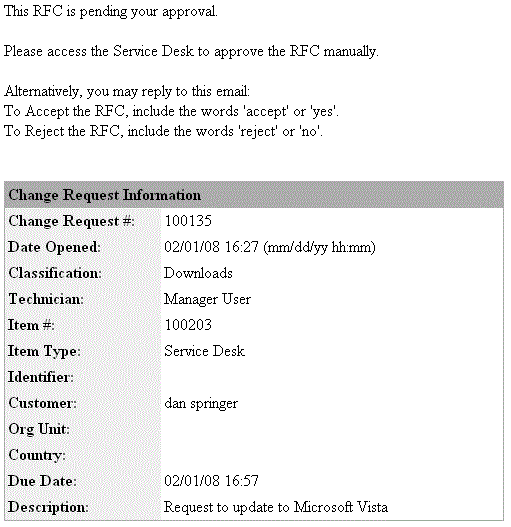4.3 Change
4.3.1 Change Requests

Manager access provides a read only view of Change Requests logged with the application.
The Change Request tab defaults to display all Requests for Change (RFCs) logged within the system. The available List Filters include:
|
Filter |
Description |
|---|---|
|
All Change Requests |
Displays all Change Requests logged in the system regardless of their Status or Assignment. |
|
Pending Approvals |
Provides the User with quick access to a list of Change Requests that require Manager approval. (This is only available if the User has Manager access.) |
The default display is ten RFCs per batch. The list can be re-sorted by clicking on a column header and the number of RFCs displayed per batch can be altered using the Display pop-up option.
Change Request Search Tips
-
Note the Change Request search option has a default Status to search only Active Requests. To ensure search success, select the relevant Incident Status, if unsure, select All
-
To search for multiple RFC numbers at once, insert a comma separator between ID numbers
-
To search based on an RFC status, select the RFC Workflow option from the Workflow drop-down list. Once selected, a list of states will be displayed
-
To search by Classification, select an Item Category from the Category drop-down list. After the category is chosen, a list of Classifications are displayed
-
To search based on the content of an RFC Description, select the Full Text option within the Search and enter a relevant term (See: Full text searches.)
-
To search using an Item's Custom field information, select the Item Category to display any Custom Fields enable for that Item.
Viewing Change Request Information:
To view RFC details, select the relevant RFC Reference # hyperlink and the screen will default to the Summary tab. The Summary tab provides comprehensive details related to the RFC.
The summary information includes the following:
|
Summary Tab |
Description |
|---|---|
|
Contact |
Displays the Customer assigned to the RFC and their contact information. Click on the Customer Name or Org.Unit link for more details relating to Customer and Org Unit. To update the Customer details assigned to the request, click on the Customer tab and ensure the Request is in edit mode. |
|
Item |
Displays the Item assigned to the RFC. Scroll over Click
|
|
Details |
|
|
Classification |
Displays the RFC Classification that was selected when the Change Request was created. This can be updated, if required. |
|
Priority |
Shows the Priority of the RFC, which determines the Service Level triggers applied to the Request. If the Derived option is enabled in the applications Setup, then the Urgency and Impact drop-down lists are displayed. The User is required to select the corresponding Urgency and Impact for the Change Request to alter the Priority assigned. |
|
Escalation |
This is visible if the Escalation Control option is enabled in the application Setup. This is only available to the Supervisor, and allows them to disable the escalation timers. |
|
Escalation Layer |
Shows the name of the current Group of Users assigned to the Request. When the Workflow State is updated, this could also result in an update of the assigned Group of Users. |
|
Technician |
The name of the Technician assigned to the RFC. |
|
Notification |
|
|
Customer |
Shows how updates regarding the RFC are sent to the Customer who logged the RFC, or to all Owners of the Item associated with the RFC. Customer CCs is a free text field for any additional notification recipients, these can be divided into Customer and Technician CC lists. |
|
Technician |
Allows the User to adjust the default Technician notification between None, Email or SMS for updating the assigned Technician, all Technicians in the Team or Layer of Escalation assigned to the RFC. Technician CCs is a free text field for any additional notification recipients, these can be divided into Customer and Technician CC lists. |
|
Alternate Team |
Is visible if the Notify Alternate Team option is enabled in the Admin>Email>Setup tab. This allows the User to define another Team to be notified about updates regarding the RFC. |
|
Change Request |
|
|
Team |
Displays the default support Team assigned to the RFC. This can be changed by selecting another option within the drop-down list. The Team list is derived from the Workflow and Workflow State. |
|
Workflow |
Displays the default Workflow assigned to the RFC. This can be changed by selecting another option within the drop-down list. The Workflow list is derived from the SLA assigned to the RFC. Select |
|
Status |
Shows the current Workflow State of the RFC. |
|
Next Action |
Lists all the states available after the current RFC State. This is based on the Workflow assigned to the RFC. To move the RFC through the Workflow, select a Status included in the list displayed. By assigning a different Workflow State, the Work or Manager Group assigned to the RFC may also be automatically updated, based on the Workflow and Team Configuration. Refer to the Escalation Layer and Technician Fields to view if an assignment change is made as part of the Status update. |
|
Status Due |
Details the expiry time for the current Workflow State if the State has an OLA assigned. |
|
Service Terms |
|
|
Agreement |
Displays the Service Level Agreement assigned to the RFC. The service level is derived from either the Item, Customer or Organizational Unit. |
|
Service Manager |
Displays the name of the Service Level Manager responsible for overseeing Requests related to the assigned service agreement. |
|
Progress |
Visually displays how the RFC is tracking against the assigned SLA and displays the percentage of SLA used when greater than 10%. The grey progress bar is gradually filled in based on the status:
|
|
Dates |
Summarizes the important date details for the RFC. The Due Date is automatically calculated based on the Service Level assigned to the RFC. |
|
Time Recorded |
Displays the amount of time the Request has been open and worked on. |
|
Affects |
Displays the number of Users assigned to the Item. |
4.3.2 RFC Approval Process
As part of the Change Management approval process, Users that have a Manager Role and are assigned to a Change Management Team can approve or reject Change Requests. To allow a Manager to approve an RFC they must be assigned to the Change Workflow Approval State. (See:Change Teams.) Then, when an RFC is moved into an Approval state, the Manager is assigned the RFC allowing them to view and reject or accept the RFC.
The security of the approval process can be enhanced by forcing the assigned Manager to re-enter their User Name and Password when processing a request. This is achieved by enabling the Strong Authentication option for the Team. (See: Change Teams.)
The system allows Managers to approve an RFC via the application's interface and email.
Accept or Reject an RFC via the application
-
Select the Change tab
-
Select the filter option Pending Approvals
From the list provided select a Request ID hyperlink.
-
Click Edit
The Accept and Reject will be available to process the RFC.

-
Select the Next Action option
Click Accept (
 ) or Reject (
) or Reject ( ) button to move the Change Request into the relevant pre-defined state and re-assign the RFC to a Technician allocated to the Status.
) button to move the Change Request into the relevant pre-defined state and re-assign the RFC to a Technician allocated to the Status. -
Enter Authentication details, if prompted
When the Strong Authentication option is enabled for the Change Team associated with the request, an Approve Change Request window is displayed prompting the User to enter their Password details. Enter your Password and select the Authenticate button and click
 to close the pop-up window.
to close the pop-up window. -
Enter additional details in the Notes Tab, if relevant
A Notes window is displayed to allow the Manager to add detailed information regarding the approval option selected.

-
Click Add Note.
Note that the Manager User will no longer be able to edit the RFC after the selection is made, and the RFC will continue through the RFC Workflow lifecycle.
NOTE:If the Approval State is configured to be an Item Details Editable State, the Manager can amend the Item details when the RFC is in this State.
Accept or Reject an RFC via email
To use the Manager RFC approval process via email, the following configuration must be in place:
The Administrator must configure the system Setup>Email screens to include:
-
Email Polling functionality
-
Create Incidents via Email option
-
Customise the ApproveChange email content, as required.
The Supervisor must also include an incoming email address for the Change Team.

When an RFC is escalated to a Change Approval state, an email is sent to the assigned Manager User informing them that an RFC is pending approval. The Manager can approve or reject the Change Request by simply replying to the escalation email using the words Accept /Yes or Reject/No.
When the system polls for incoming email, the Manager's response is automatically applied to the relevant RFC and based on the Manager's response, the RFC is routed to a Technician allocated to the next Workflow state. The Manager is also sent a confirmation email informing them that their selected action has been applied to the RFC.
Example of email sent to Manager:

 to view Item information recorded on the Details tab. Select the Type hyperlink for more information about the Item.
to view Item information recorded on the Details tab. Select the Type hyperlink for more information about the Item. to view the Item Relationship map. Any Item displayed in the map can be set as the Item associated with the Incident, by making it the central node of the Relationship map and clicking on the centralized map icon to confirm the Item assignment change.
to view the Item Relationship map. Any Item displayed in the map can be set as the Item associated with the Incident, by making it the central node of the Relationship map and clicking on the centralized map icon to confirm the Item assignment change. is visible next to the Item Type, if the RFC is in a Workflow State with the Item Editable option is set to Yes. Click the icon to edit the Item details.
is visible next to the Item Type, if the RFC is in a Workflow State with the Item Editable option is set to Yes. Click the icon to edit the Item details. is visible when the RFC is created as part of the "Control CMS via RFC" functionality and the RFC was created due to an Item update or creation. It appears in an Item Editable stage of the Change Workflow and allows the Item update details that prompted the creation of the RFC, which will be detailed in the Description field, to be applied to the CMDB.
is visible when the RFC is created as part of the "Control CMS via RFC" functionality and the RFC was created due to an Item update or creation. It appears in an Item Editable stage of the Change Workflow and allows the Item update details that prompted the creation of the RFC, which will be detailed in the Description field, to be applied to the CMDB. to view the Workflow in its entirety.
to view the Workflow in its entirety. - Workflow is in an SLA paused State. Triggers will not fire.
- Workflow is in an SLA paused State. Triggers will not fire. - Workflow is in an SLA timers on State. Triggers will fire.
- Workflow is in an SLA timers on State. Triggers will fire. - Workflow is in an Exit State and the SLA has been successfully maintained.
- Workflow is in an Exit State and the SLA has been successfully maintained. - Assigned SLA has been breached and Workflow is in an Exit State.
- Assigned SLA has been breached and Workflow is in an Exit State.